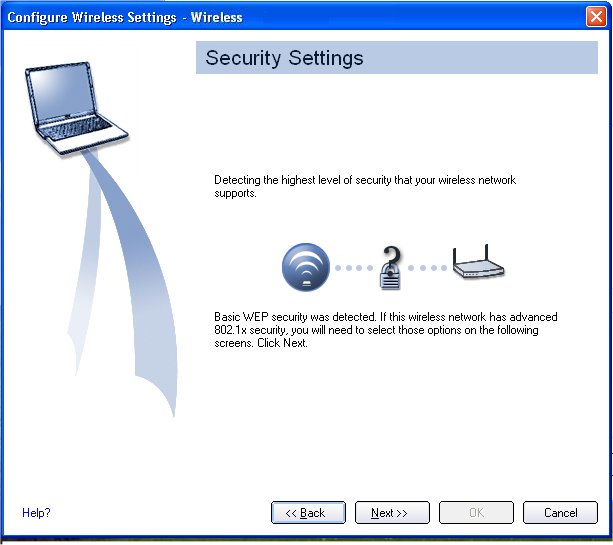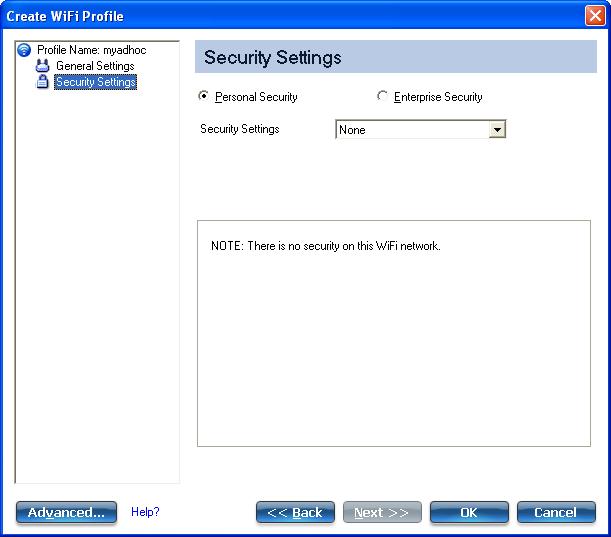
NOTE: This section describes profiles created with Intel(R) PROSet/Wireless WiFi Connection Utility. These profiles are not used by Microsoft Windows XP Wireless Zero Configuration.
NOTE: Throughout this Help, the terms "wireless" and "WiFi" are used interchangeably.
A profile is a saved group of network settings. Profiles are displayed in the Profiles List. Profiles are useful when moving from one wireless network to another. Different profiles can be configured for each wireless network. Profile settings include the network name (SSID), operating mode, and security settings.
A profile is created when you connect to a wireless network.
The Create WiFi Profile Wizard guides you through the settings required to connect with the wireless network. At completion, the profile is saved and added to the Profiles list. Since these wireless settings are saved, the next time you are in range of this wireless network you are automatically connected.
There are two basic types of profiles that can be used to connect to a wireless network. The profile types are:
The Profiles list displays a list of existing profiles. When you come in range of a wireless network, the WiFi connection utility software scans the Profiles list to see if there is a match. If a match is found, you are automatically connected to the network.

The network profile status icons indicate whether the adapter is associated with a network, the type of operating mode being used, and whether security encryption is enabled. These icons display next to the profile name in the Profiles list.
| Name | Description | |
|---|---|---|
The Profile Name is your name for this network. It can be anything that helps you identify this network. For example, My Home Network, Coffee Shop on A Street. |
||
Network Name |
Name of the wireless network (SSID) or computer. |
|
Connection Icons: The network profile status icons indicate the different connection states of the adapter with a wireless network, the type of operating mode being used, and whether network security is being used. |
||
Blue circle: The WiFi adapter is associated with an access point or computer (Device to Device [ad hoc] mode). If a profile has 802.1X security enabled, this indicates that the WiFi adapter is associated and authenticated. |
||
|
Indicates Network (infrastructure) mode. |
|
|
Indicates Device to Device (ad hoc) mode. |
|
Indicates an Administrator profile. |
||
|
The wireless network uses Security encryption. |
|
| Indicates that this network is on the Exclude list, e.g. is set for manual rather than automatic connection. When on the Exclude list, to connect the user must connect manually. | ||
Arrows
|
Use the arrows to position profiles in a preferred order for auto-connection.
|
|
Connect |
Connect the selected profile for the wireless network. |
|
Opens the Create WiFi Profile General Settings, which are used to create a new profile. See Create a New Profile for more information. |
||
Removes a selected profile from the Profiles list. See Remove a Profile for more information. |
||
Used to edit the contents of an existing profile. You can also double-click a profile in the Profiles list to edit the profile. See Edit an Existing Profile for more information. |
||
|
Export/Import: Imports and exports user-based profiles to and from the Profiles list. Wireless profiles can be automatically imported into the Profiles list. See Export or Import Profiles for more information. |
|
Close |
Closes the profile management window. |
|
Help? |
Provides help information for this page. |
|
When you are in range of a wireless network that has a matching profile you are automatically connected to that network. If a network with a lower priority profile is also in range you can force the connection to that lower profile. This is achieved the from the WiFi connection utility or from the Taskbar icon.
Manually connect to a profile from the Intel PROSet/Wireless WiFi software:
Manually connect to a profile from the Taskbar:
Select a network from the WiFi Networks list. Click Connect. The Create WiFi Profile manager guides you through the necessary steps to create a profile and connect to the network. During this process, the Create WiFi Profile Security Settings attempts to detect the appropriate security settings for you.
To create a new profile and connect to a wireless network:




To edit an existing profile:
To remove a profile:
If you are still connected to the network:
NOTE: If the profile is protected by a password, you cannot remove or edit the profile settings without entering the password. If the administrator or you do not know the password, there is no process available to reset the password.
To password protect an existing profile:
This feature lets you import and export user-based profiles to and from the Profiles list. Wireless profiles can be automatically imported into the Profiles list.
An administrator can set profiles to be imported automatically into the Profiles list. Intel PROSet/Wireless WiFi Connection Utility monitors the import folder on your hard disk for new profile files. Only profiles that have been enabled through Enable Auto-Import in the Advanced Settings are automatically imported. If a profile of the same name already exists in the Profiles list, you are notified to either reject the imported profile or accept it. If accepted, the existing profile is replaced. All imported user-based profiles are placed at the bottom of the Profiles List.
NOTE: To export Administrator profiles, see Administrator Packages.

To import profiles manually:
To select multiple profiles:
Import and export password-protected user-based profiles automatically to remote systems. If a profile is password protected, the assigned password must be entered before it can be edited. See Set a Profile Password for more information.